
HMS J7 was a J-class submarine operated by the Royal Navy and the Royal Australian Navy.
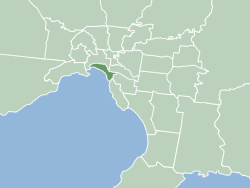
The City of Port Phillip is a local government area of Victoria, Australia on the northern shores of Port Phillip, south of Melbourne's central business district. It has an area of 20.7 km2 and had a population of 113,200 in June 2018.

Port Melbourne is an inner-city suburb in Melbourne, Victoria, Australia, 3 km (2 mi) south of the Melbourne central business district, located within the Cities of Melbourne and Port Phillip local government areas. Port Melbourne recorded a population of 17,633 at the 2021 census.

The Queen Victoria Market is a major landmark in the central business district (CBD) of Melbourne, Victoria, Australia. Covering over seven hectares, it is the largest open air market in the Southern Hemisphere.

St James Old Cathedral, an Anglican church, is the oldest church in Melbourne, Australia, albeit not on its original site. It is one of the relatively few buildings in the central city which predate the Victorian gold rush of 1851. The building was dismantled and relocated in 1914 to a corner site of King Street and Batman Street.
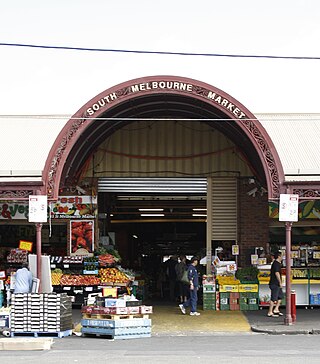
The South Melbourne Market is a covered food and general goods market located in South Melbourne, Victoria.

Northcote Town Hall Arts Centre is an arts and community centre located in High Street in Northcote, a suburb of Melbourne, Australia.

Fitzroy Town Hall is a civic building located in Napier Street in Fitzroy, a suburb of Melbourne, Australia.

Prahran Town Hall is a civic building located on the corner of Chapel Street and Greville Street in Prahran, a suburb of Melbourne, Australia.

St Kilda Town Hall is a grand, classically styled city hall, located on the corner of Brighton Road and Carlisle Street in St Kilda, Victoria, Australia. The first stage, never completed, was built as the municipal offices and public hall for the former City of St Kilda in 1890. Many additions, internal alterations, and changes in appearance were made in the early and mid 20th century, while serving as the municipal and social heart of St Kilda. A devastating fire in 1991 seriously affected the art collection and burnt out the hall itself, and was followed by a prize winning refurbishment and further extension. After Council amalgamations in 1994, it became the base for the larger City of Port Phillip, and further extensions and renovations have occurred. The hall within remains popular for numerous social events, meetings and performances, a role it has served for over 120 years.
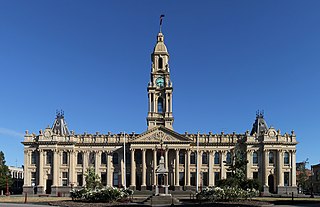
South Melbourne Town Hall is a landmark civic building located on Bank Street in South Melbourne, a suburb of Melbourne, Victoria, Australia. It is listed on the Victorian Heritage Register as of state heritage significance to Victoria.
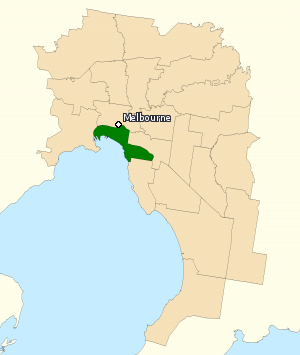
The Division of Melbourne Ports was an Australian federal electoral division in the inner south-eastern suburbs of Melbourne, Victoria, Australia. It was located to the south of Melbourne's central business district and covered an area of approximately 40 km2 around the north and north-eastern shores of Port Phillip Bay.
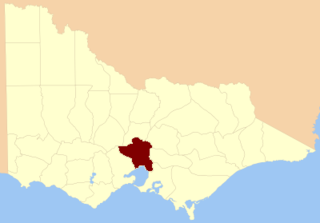
The County of Bourke is one of the 37 counties of Victoria which are part of the Lands administrative divisions of Australia,. It is the oldest and most populous county in Victoria and contains the city of Melbourne. Like other counties in Victoria, it is subdivided into parishes. The county was named after Irish born Sir Richard Bourke, the Governor of New South Wales between 1831 and 1837. It is bordered by the Werribee River in the west; the Great Dividing Range in the north; Port Phillip in the south; and by Dandenong Creek, a small part of the Yarra River, and the Plenty River in the east. The county was proclaimed in 1853.

The City of Richmond was a local government area about 2 kilometres (1 mi) east of Melbourne, the state capital of Victoria, Australia. The city covered an area of 6.12 square kilometres (2.36 sq mi), and existed from 1855 until 1994.
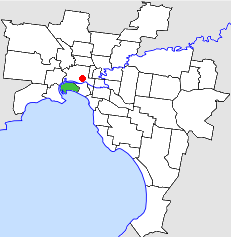
The City of Port Melbourne was a local government area about 4 kilometres (2 mi) southwest of Melbourne, the state capital of Victoria, Australia, on the south bank of the Yarra River. The city covered an area of 10.62 square kilometres (4.10 sq mi), and existed from 1860 until 1994.
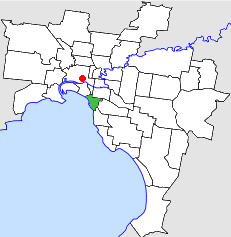
The City of St Kilda was a local government area on Port Phillip, about 5 kilometres (3.1 mi) south of Melbourne, the state capital of Victoria, Australia. The city covered an area of 8.70 square kilometres (3.36 sq mi), and existed from 1855 until 1994.

The City of Brighton was a local government area about 10 kilometres (6.2 mi) south of Melbourne, the state capital of Victoria, Australia. The city covered an area of 13.48 square kilometres (5.20 sq mi), and existed from 1859 until 1994.
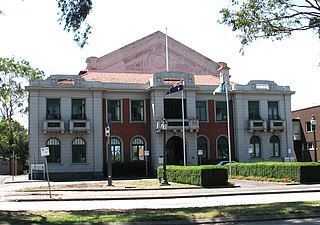
Williamstown Town Hall is a civic building located in Williamstown, a suburb of Melbourne, Australia.

Port Phillip Arcade was a small arcade in Melbourne, the capital city of the Australian state of Victoria with several cafés and general food outlets. It connects Flinders Lane with Flinders Street between Swanston Street and Degraves Street.
South Yarra Province was an electorate of the Victorian Legislative Council from November 1882 until May 1904.



















